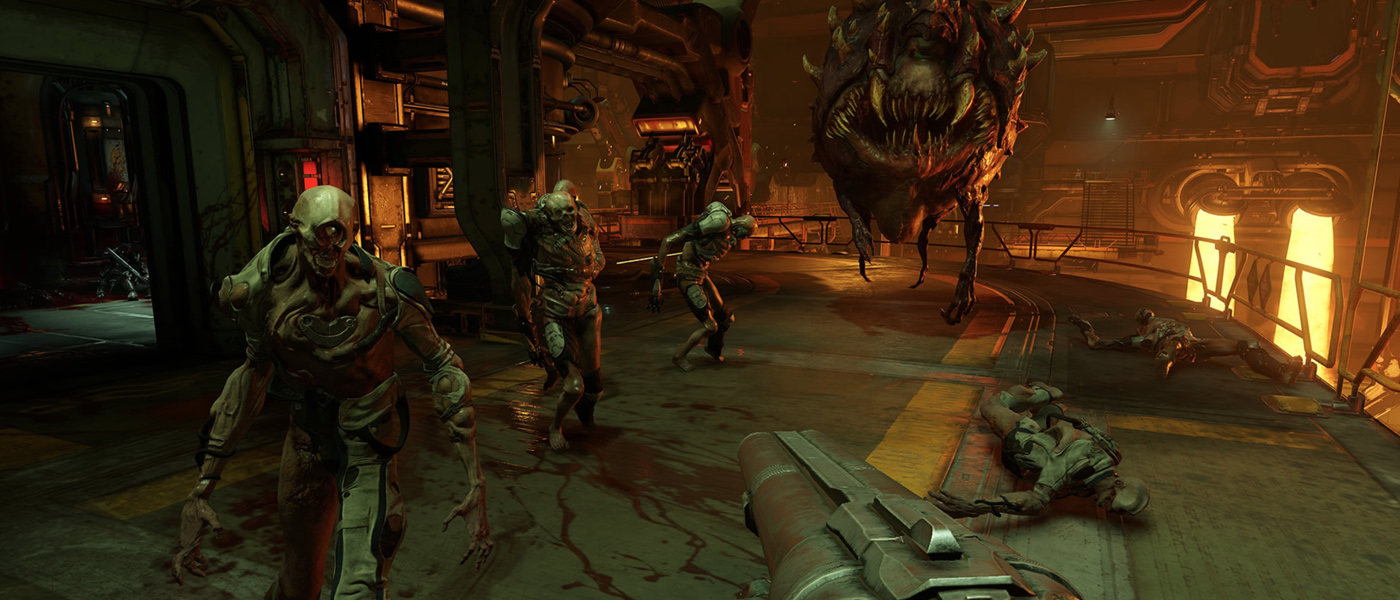After over a decade in hibernation Doom Guy is back, and he’s brought with him everything that made DOOM a household name so long ago. If you’ve been craving the kind of fast paced, ball busting action that DOOM and DOOM II offered and didn’t quite gel with the slower pace and emphasis on atmosphere that DOOM 3, and to a lesser extent DOOM 64, brought to the table then it’s time for you to go to Hell. Again.
Despite being set in the all too familiar with UAC base on Mars, DOOM (2016) manages to differentiate itself from the rest of the series before you even take control. This iteration of Doom Guy is an ancient warrior of unknown origin found in a stone casket during an exploration into Hell. Samuel Hayden, the head of the UAC, has created a means for humanity to siphon the power of Hell itself, Argent Energy. When Olivia Pierce, a researcher for the UAC, has fallen under the influence of Hell and attempts to help its demonic denizens rip and tear their way into our world and it’s up to the newly reawakened Doom Guy to stop her.
As it should be, DOOM (2016) is light on story. This may disappoint some fans of the more fleshed out universe of DOOM 3, but for what it is, the bare bones plot serves as a great excuse to dismember thousands of demons over an eight to ten hour run through of the campaign. That said, fans of the DOOM 3 style world building are thrown a bone in the form of a rather extensive codex filled with information of every monster, level, weapon, and character in the game. When you do take the time to read through all this info you get a pretty good look at the world of DOOM and I appreciate the effort that went into the lore surrounding this otherwise simple story. I’d also like to point out the small additions to Doom Guy as a character, few as there may be. Things as simple as the T2 reference he makes when dying in lava or the little fist bump he gives to a particular collectible doll made in his image do a lot to paint him as a walking tank with a sense of humor, and a few story beats I don’t want to spoil give him both direction in his actions and a tiny bit of humanity, too.
It may seem a bit odd to jump into the story of a DOOM game before anything else, but I’ve got my reasons. Those two paragraphs are about all I could squeeze out of the plot so it’s best to get it out of the way now. The gameplay, though? I’ve got a lot to say. From the second – the absolute second – you take control the game’s action starts and never really slows down beyond a minute or two of exposition every now and again. Hell, before you even press a button in the campaign Doom Guy has already killed an enemy, in a glorious way at that. That’s the beauty of this new take on DOOM; it isn’t exactly new. It’s a loving reconstruction of the same frenetic, nonstop action that made DOOM famous. If you missed that adrenaline rush from ice skating along the ground, weaving in and out of enemy fire patterns, and splitting heads open with a combination of futuristic weapons and animalistic brutality then it won’t take more than fight to slip back into your virtual combat boots and effortlessly pick up right where you left off back in the 90’s. I mean, looking up might take some getting used to if you’ve been out of the FPS loop since then, but whatever.
Everything about the gameplay here clicks. You start out with a dinky handgun with a charge shot alt-fire, but within ten minutes you’re given a shotgun and the stream of ever more bad ass weaponry doesn’t stop until you’re facing off with the final boss. These guns aren’t just great visual call backs to their classic DOOM counterparts, they’re just as satisfying to use, if not more so. It’s been a while since shooting something has felt this good for me. It’s easy to draw parallels to the recent reboots of Shadow Warrior and id’s own Wolfenstein when it comes to combat scenarios and gunplay, but DOOM manages to outclass even those games when it comes to sheer satisfaction. Headshots are meaty, sound effects are chunky and loud, impacts are powerful, and Doom Guy doesn’t simply reload weapons like a modern action game hero, he wills bullets into his gun with no break in the action. Even the BFG is back and as over powered as it ever was. I adore Shadow Warrior’s recent reboot and Wolfenstein’s New Order and Old Blood were great revivals but after hours with DOOM, I can safely say they simply don’t compare from a gameplay perspective.
Even with all those fantastically fun options for fire arms, you’re not just limited to guns. The chainsaw is back and what it lacks in versatility – the new version requires gas while the old games’ saw seemed to be powered by sheer balls – it makes up for in its new functions. It’s no longer a simple equippable weapon like any other, but a side arm that acts as a quick method to take out any enemy in the goriest way possible but also causes their corpses to explode into ammunition pinatas, spewing bullets and shotgun shells in all directions. It’s a great way to restock and serves as a sister mechanic for one of DOOM’s legitimate advancements from its predecessors; Glory Kills. Staggering an enemy will give you a short window where in you can perform a hilariously graphic finishing move on them, which in turn causes them to burst into gore and a rain of health pick ups and, with the right Rune augmentation, armor shards. These kills could get old for some, but the canned animations are still hilarious to me and they’re essential in bigger arena battles where health isn’t naturally available.
Speaking of Runes, there’s a bevy of options when it comes to combat in this iteration of DOOM. Most levels house two hidden Rune Trial segments, challenges that grant you an equippable Rune on completion. These Runes give you abilities ranging from increased range and stagger time for your Glory Kills, better mobility in the air, and on the extreme end the ability to resurrect after death and infinite ammo when your armor count is about one hundred. Each Rune also comes with a small challenge tied to its ability that, should you choose to complete it, makes their powers even stronger. This progression is a persistent aspect of DOOM and while it does complicate the intentionally simple nature it also gives players more options and abilities than a lot of similar FPS. In fact, the weapon upgrades offer an insane amount of options. Finding little flying drones in each level unlocks an alternate fire mode and all but two of weapons come with two wildly different variations. The minigun turns into a mobile turret and the AR can shoot missile swarms. Missile. Swarms.
So you have a ton of guns that feel great to use and offer you a plethora of options, yeah? Pointless if there are enemies that are fun to shoot, and DOOM nails that, too. All the classics are back; Imps, Mancubi, and even Pinkies return and all act like roided up versions of their past selves. Imps, for example, feel like something out of id’s Rage, bounding up walls and flanking you in packs. A far cry from the slowly waddling fireball lobbers of old. That rings true for most enemies. They look like updated versions of their old sprites and feel like something id would’ve done if the tech of ’93 allowed it. The only downside to the enemies is the fact that the Cyberdemon, like in DOOM 3, is relegated to a boss rather than a regular enemy, which sucks because its design here is probably its coolest.
Outside of endless hordes of enemies to eviscerate, there’s plenty of exploration and platforming to keep you entertained. DOOM and platforming may not seem like the best bedmates, but it feels almost Metroid Prime-esque and is as solid as platforming in FPS like these can get. The maps are fairly large and non-linear, exploration is encouraged by a handful of secrets in each stage including the usual collectible logs and, more importantly, hidden chunks of DOOM and DOOM II stages that unlock full versions of their counterparts that are playable from the main menu. It’s kind of surprising how much content there is here.
On a technical scale, Doom is on point. I played through on PS4 and was impressed with the visuals, it ran stably and looks like DOOM should. From the comparisons I’ve seen the PC version offers sharper visuals and much faster load times. Load times on the console version are a bit rough. On death or at the end of each stage you’re looking at a minute and a half of loading. That’s the biggest shortcoming of DOOM as far as the technical aspects go, and when you take in the whole package it’s a bit of a minor quarrel but it still sucks.
Overall, the campaign is damn near perfect to the point that it’s a bit tough for me to conjure up any negatives. Others have mentioned a distaste for the pacing and overbearing upgrade system, but I found no issue in either case. If you’re hankering for action then DOOM is for you, it delivers in spades with one of the coolest campaigns in recent memory and a neat return to the keycard hunting and maze running of old with none of the set pieces and hallways we’ve gotten used to in modern FPS. For fans of old school action I can’t recommend it enough.
The multiplayer, on the other hand, I can’t really justify trying. It’s a bizarre mishmash of Quake or Unreal style arena combat and CoD style loadouts and progression. It’s fun for a few rounds, there are some cool modes, but it all seems kind of pointless when there are so many other options out there. The third pillar of DOOM is its new SnapMap system. It’s an in depth level creation tool that has a ton to offer creative types. I’ve seen it compared to LittleBigPlanet but for shooters and after trying a handful of maps and seeing multiple dedicated to grinding trophies and recreating levels from other games I can say that’s a very fair example. As of now the tool has a lot of potential that hasn’t quite been met, but I can see a ton of great things coming out of this editor. It’s no substitute for slapping a new .WAD into your game and playing as a Ghostbuster or Batman like the old days, but it’s a cool way to extend the games’ life and offer up and coming creatives a taste of level design and programming training.
To close, DOOM is exactly what it wants to be. It’s easily one of the best FPS I’ve played in years and, like Shadow Warrior and Wolfenstein before it, I’m happy to see it claw its way back into relevancy. The campaign’s ending leaves it open for a sequel, and with the former games having expansions and sequels available and forthcoming I can only hope DOOM follows suit. I just don’t wanna wait another decade to chainsaw the face off a horned hell-beast again.



